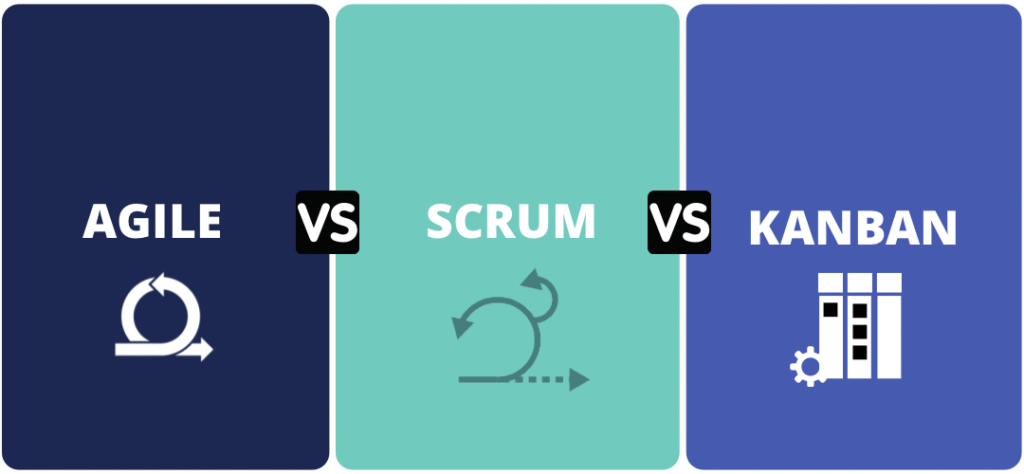Introduction
In the fast-paced world of work and project management, being agile is crucial. To help with this, three popular methods have emerged: SAFe, Scrum, and Kanban. They each have their unique ways of getting things done, and it’s important to know how they differ. In this blog, we’ll break down the key points of SAFe, Scrum, and Kanban to help you figure out which one might work best for your team.
1. SAFe (Scaled Agile Framework)
SAFe is all about handling big projects in big organizations. It’s like a big toolbox for making sure everyone is on the same page and working together. Here are some things to know about SAFe:
Big Scale: SAFe is for really large companies and projects that need lots of people working together.
-Roles and Jobs: In SAFe, there are many job titles and roles like Release Train Engineer, Product Owner, and Scrum Master. Each of these roles has a specific job to do.
-Events and Stuff: SAFe has meetings and things like Program Increment Planning and Inspect and Adapt workshops to keep everyone on track.
-Timing: SAFe likes to work in set time periods, often around 8-12 weeks. This helps all the teams stay in sync.
-Some Flexibility: While SAFe has rules, it also allows teams to change things a bit to fit their needs.
2. Scrum
Scrum is a straightforward way to get work done. It’s most commonly used for building products but can be used in many fields. Here’s what you need to know about Scrum:
-Roles and Jobs: Scrum has three main roles: Scrum Master, Product Owner, and Development Team. Each role has a clear job description.
-Events: Scrum is like clockwork. It has set events: Sprint Planning, Daily Scrum, Sprint Review, and Sprint Retrospective.
-Things on Paper: Scrum uses lists and plans called Product Backlog, Sprint Backlog, and Increment to keep track of work.
-Learn as You Go: Scrum is all about trying things and learning from them.
-Fixed Roles and Events: Scrum has strict roles and events that can’t change much, making it easy to follow.
3. Kanban
Kanban is all about keeping things moving smoothly. It’s great when your work comes in at different times or needs flexibility. Here are the basics of Kanban:
-See the Work: Kanban uses boards with cards to show what needs to be done and what’s already finished.
-Limits on Work: It sets limits on how many things can be worked on at once. This stops people from getting overwhelmed.
-Never Stops: Unlike Scrum, Kanban doesn’t have fixed time periods. Work flows all the time, and you finish things when you’re ready.
-Change It Up: Kanban is really flexible and can fit into all sorts of jobs and situations.
-Less Rules: Kanban has fewer rules and roles compared to Scrum, so it’s easy to get started with.
Comparing SAFe, Scrum, and Kanban
Now, let’s put these three methods side by side:

1. For Big or Small?
– SAFe is for big companies and projects.
– Scrum and Kanban work well for smaller teams and projects.
2. Who Does What?
– SAFe has lots of different roles.
– Scrum has three clear roles.
– Kanban needs fewer roles.
3. What’s the Schedule?
– SAFe and Scrum have set schedules.
– Kanban doesn’t have a set schedule; it goes with the flow.
4. Can You Change Things?
– SAFe and Scrum have more fixed rules.
– Kanban is really flexible.
5. Seeing the Work
– Kanban is all about visual boards.
– SAFe and Scrum use them but not as much.
6. Limits on Work
– Only Kanban sets limits on how many things can be done at once.
Conclusion
SAFe, Scrum, and Kanban are like different tools in a toolbox. SAFe is for big projects in big organizations, Scrum is straightforward and strict, and Kanban is flexible and flow-oriented. Your choice depends on your team’s size, needs, and how much flexibility you want. Some teams even mix and match these methods to create their own unique approach. The main thing is to keep an open mind and keep improving the way you work to succeed in today’s fast-moving world.










